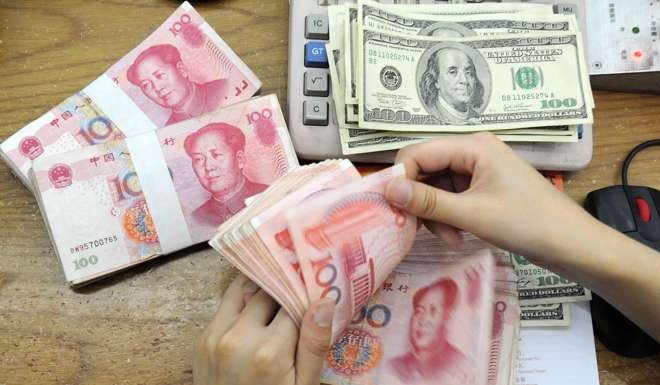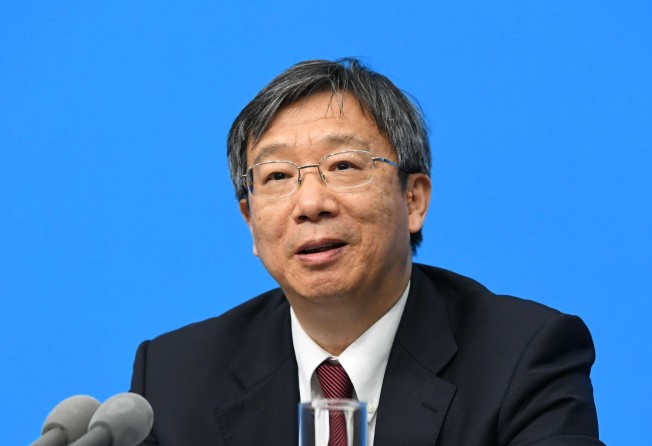
China’s central bank talks up the yuan against US dollar ‘uncertainties’
PBOC may intervene before dollar-yuan rate breaks key point, say analysts

China’s central bank stepped in on Sunday night to provide “forward guidance” support for the Chinese currency by talking up the yuan against the US dollar.
In an apparent move to ease market concerns over weakening of the yuan and capital flight from China, Yi Gang, a deputy governor of the People’s Bank of China, said in an interview with Xinhua that prospects for the US dollar are uncertain but the yuan is a “stable and strong” currency and its depreciation against the dollar was less than that of the Japanese yen or the euro.
Yi’s comments indicated the PBOC might intervene in the foreign exchange market to support the yuan before the dollar-yuan rate broke the key level of 7, as rapid depreciation of the yuan and capital exodus could mutually reinforce each other, analysts said. China has already burnt through more than US$800 billion of forex reserves in the past two years to prevent a free fall of the yuan exchange rate.

“Yi’s comments were set to call for market rationality, trying to persuade market participants not to rush to the US dollar,” said Tan Yaling, head of the China Forex Investment Research Institute.
In case the market didn’t listen, the central bank was ready to upgrade its capital account control in “a flexible and dynamic way”, Tan said.
A rally in value of the US dollar has been widely attributed to the recent weakening of the yuan.
Yi, the central bank official, was quoted as saying the yuan’s weakening was not a problem with China but a result of “Trump’s win in the US presidential election, higher expectations on the Fed to raise interest rates, Britain’s decision to leave the EU as and the free floating Egyptian pound”.
“But the prospects for the US dollar have uncertainties, and it can’t be ruled out that the dollar will retreat if market expectations are corrected,” Yi said.
Shen Jianguang, chief economist of Mizuho Securities Asia, said Yi could have a point, and China would be able to keep the exchange rate around 7 for the remainder of this year and 7.3 until the end of 2017.
“China has lots of ‘soft constraints’ to control the speed of capital outflow, such as instructions on enterprises and scrutiny over individuals’ needs,” Shen said. “Outbound investment in property or other purely financial investment could also be strictly reviewed.”
Cross-border mergers and acquisitions are major means of capital outflow. Outbound investment reached US$134.2 billion in the first three quarters, compared to US$95.1 billion of foreign direct investment in the same period.
Louis Kuijs, head of Asia economics at Oxford Economics, said the exchange rate of 7 yuan to the dollar was a key “intervention” yardstick.
“Policymakers will not shy away from further tightening capital account restrictions if needed. They could also take lower-profile steps such as slowing down state-owned enterprise’s outbound investment and banks’ overseas lending,” Kuijs wrote in a research note on Monday.
Heng Koon How, senior forex strategist at Credit Suisse in Singapore, said: “Yi Gang’s words signal that the PBOC may think the yuan has had too much weakening in the short term, and some consolidation is needed.
“It’s time for the PBOC to make moves to stabilise the yuan and it is likely to maintain the yuan around 6.9 per US dollar at least until the (Federal Open Market Committee) meeting mid December,” Heng said.
China also has the capability to slow the pace of depreciation if necessary.
China’s forex reserves fell US$45.6 billion in October when yuan depreciation accelerated, but analysts largely attributed that to value changes in the dollar against other currencies, rather than an absolute fall. The size of the monthly fall was also much lower than the largest drop of US$108 billion recorded in December 2015.
“It will take three years for China’s forex reserves to fall to US$2 trillion according to the current pace, while there will be huge uncertainties over the trend of the US dollar index in that period,” Shen Jianguang forecast.
Unlike the panic over uncertainties in the PBOC reform late last year, the market is generally stable given the relatively transparent exchange rate mechanism and the idea of managed depreciation.
“The good performance of the domestic stock market indicates that such forex fluctuations have largely been ignored,” said Liu Dongliang, a senior forex analyst with China Merchants Bank in Shenzhen.
“The PBOC is unlikely to set a bottom line for intervention since that is against the market-oriented reform, but it may step in to support the currency at key psychological levels,” he said.
Additional reporting by Cathy Zhang